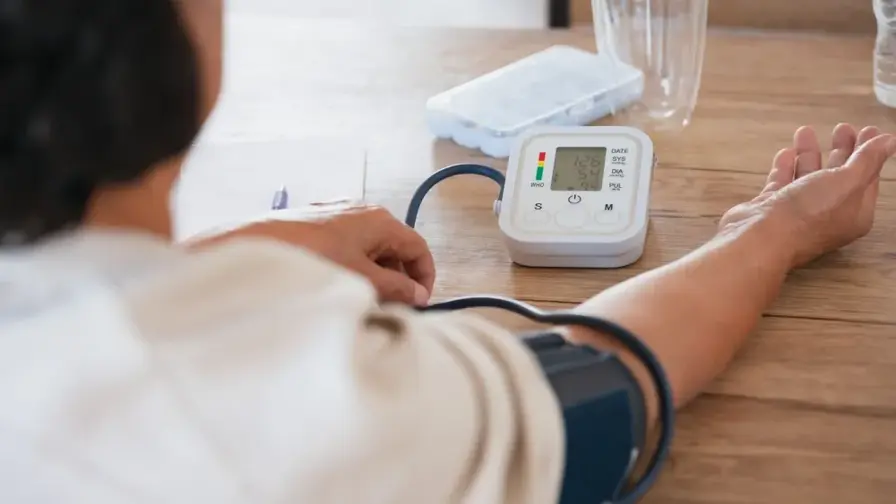Is high blood pressure in women related to gynecological diseases? Study warns: Risk of uterine fibroids increases by 45%

Suffering from high blood pressure not only affects cardiovascular function; it may even increase a woman’s risk of “uterine fibroids”? A recent article published in the authoritative journal “JAMA Network Open” pointed out that women with high blood pressure may have a significantly increased chance of developing uterine fibroids in the future; research suggests that elevated blood pressure may cause damage to uterine smooth muscle cells, leading to the growth of fibroids.
Is high blood pressure in women related to gynecological diseases? “JAMA” study: “Uterine fibroids” risk increased by 45%
A joint research team from the University of Pittsburgh, Boston University and the University of California recruited a total of 2,570 women with an average age of about 45 years old. The subjects had no history of uterine fibroid diagnosis. The study conducted a total of 13 random visits, and the subjects’ blood pressure was measured at each visit. The study defined the diagnosis of hypertension as systolic blood pressure higher than 130 millimeters of mercury (mmHg) or diastolic blood pressure higher than 80 mmHg.
The research team also observed the subjects’ cardiovascular disease risk biomarkers (high-sensitivity C-reactive protein hsCRP, total cholesterol, good cholesterol HDL-C, bad cholesterol LDL-C, triglycerides), hypertension treatment results , hypertension drug use, different hypertension conditions, etc. There were 526 women diagnosed with uterine fibroids during the study period.
The results of the study showed that participants with new-onset hypertension had a 45% higher risk of newly reported uterine fibroids compared with participants who had never had hypertension; for participants with existing hypertension, the risk was 45% higher. There is no increasing trend. In addition, patients with untreated hypertension had a 19% increased risk of newly reported uterine fibroids compared with those without hypertension, while patients with treated hypertension had a 20% lower risk.
Of note, higher proportions of participants eligible for antihypertensive medications were non-Hispanic black and had a body mass index (BMI) of 30 or above than in the overall study population. The risk of newly reported uterine fibroids was reduced by 37% in subjects who received antihypertensive treatment, and specifically in subjects who received ACE inhibitors, the risk was reduced by approximately 48% compared with those who did not receive any treatment. In addition, BMI, fat and hsCRP were not associated with the diagnosis of new uterine fibroids; while increasing the waist-to-hip ratio by 0.1 unit, the risk of new fibroids increased by 29%.
Are women of all ages at risk? Experts point out that “1 treatment” is expected to reduce the prevalence of disease
“Several prospective studies have shown that elevated blood pressure is related to the occurrence of uterine fibroids, and there is a certain risk in women of different ages!” Dr. Susanna D. Mitro, the author of the study, said that previous studies have believed that blood pressure The cause of the increase (such as activation of the renin-angiotocin system) may cause damage to uterine smooth muscle cells, leading to fibroid hyperplasia; and the presence of uterine fibroids may also increase blood pressure.
However, Dr. Mitro emphasized that this study found that antihypertensive drug treatment may be related to preventing the occurrence of uterine fibroids. “Hypertension-lowering drugs can not only control blood pressure, but may also prevent damage to uterine smooth muscle by reducing atherosclerosis!” According to this study, the drug most relevant to reducing uterine fibroids is ACE inhibitors ( angiotensin-converting enzyme inhibitor).
Dr. Mitro also stated that the diagnosis of uterine fibroids in the subjects in this study was in a self-reported form, and it is not ruled out that patients with asymptomatic uterine fibroids may have been missed. In addition, it is currently not possible to prove that there is an absolute causal relationship between high blood pressure and uterine fibroids in women. In the future, studies with larger samples should be conducted to clarify the connection between the two.
Risk factors for high blood pressure in women? AHA warns: 6 groups should be extra careful
What are the risk factors for high blood pressure in women? According to guidelines published by the American Heart Association (AHA), women are generally as likely to develop high blood pressure as men during their lifetime; the following special life stages or events may increase a woman’s risk of high blood pressure:
Menopause. In the past, academic circles believed that the increase in blood pressure in women after menopause was related to changes in estrogen in their bodies and an increase in BMI. Changes in estrogen during menopause may cause weight gain and make blood pressure more sensitive to dietary salt.
Pregnancy. For example, “gestational hypertension” refers to a woman’s blood pressure value greater than or equal to 140/90 during pregnancy. It is usually diagnosed after 20 weeks of pregnancy or close to delivery; “preeclampsia” refers to a combination of high blood pressure and organ function during pregnancy. Conditions caused by adverse signs, such as high levels of protein in the urine.
Contraceptives. Using oral contraceptives can slightly increase a woman’s blood pressure, and is more likely to occur in women who are obese, have kidney disease, or have a family history of high blood pressure. If a woman develops significant symptoms of high blood pressure, she should discuss with her physician whether to discontinue birth control pills and treat her high blood pressure immediately.
Hormone therapy. Past studies have pointed out that women who receive hormone therapy may have a 25% increased risk of developing high blood pressure. Women who have inherently high blood pressure and require hormonal therapy should thoroughly discuss with their physician the appropriate treatment options for them.
Hyperlipidemia or hyperglycemia. High blood lipids can cause cholesterol to be deposited on the blood vessel walls, causing atherosclerosis and increasing the possibility of high blood pressure. People with poor blood sugar control may cause renal arteries and arterioles to harden, leading to a decrease in the elasticity of the blood vessel walls and an increase in systolic blood pressure. If neglected, it may develop into the “three highs” disease.
History of cardiovascular disease. High blood pressure has been shown to be strongly associated with cardiovascular disease. Hypertension in female patients may lead to an increased risk of myocardial infarction, heart failure, stroke, and kidney disease; cardiovascular events may also significantly increase the prevalence of hypertension.
Source:
High Blood Pressure and Women - American Heart Association
Hypertension, Cardiovascular Risk Factors, and Uterine Fibroid Diagnosis in Midlife**
Further reading:





